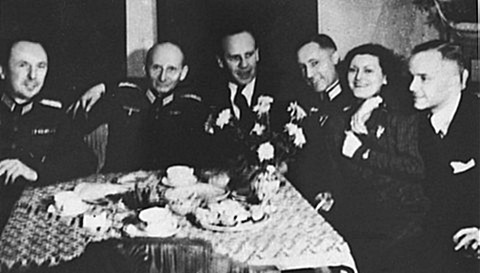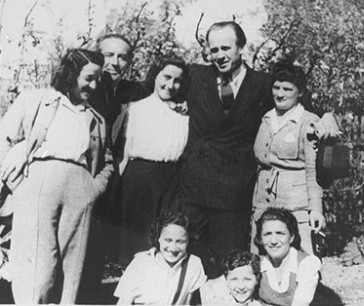
![]()

| Oskar Schindler (center) enjoys himself at a dinner party with Nazi officials in Krakow, April 28, 1942. Below: In 1946, Oskar Schindler (second from the right) poses with a group of Jews he rescued. Among those pictured are: Manci Rosner, Edmund Horowitz, Ludmila Pfefferberg-Page, Halinka Horowitz, and Olek Rosner. |

In 1939, Oskar Schindler set up a business in an old enamel works factory in Poland, employing Jews from the Krakow Ghetto as cheap labor. As the Nazis intensified persecution of the Jews, Schindler increasingly feared for the safety of his workers. He managed to convince the Nazis his factory and thus his Jews were vital to the German war effort and prevented their deportation to the death camps of the East.
Following the liquidation of the Krakow Ghetto in March of 1943, his workers were relocated to Plaszow concentration camp, a forced labor center under the brutal command of Kommandant Amon Goeth. Schindler helped his workers to survive their confinement at Plaszow by befriending and bribing Goeth.
Toward the end of 1944, Goeth was ordered to liquidate Plaszow. Schindler saved nearly 1200 Jews from certain death by convincing Goeth to allow him to relocate them to Brunnlitz, Schindler's hometown, where they were eventually liberated by the Soviets. Following the war, Schindler stayed in contact with the Jews and travelled each year to Israel to be honored by them.
![]()
(Photo credits: Prof. Leopold Pfefferberg-Page Collection, courtesy of USHMM Photo Archives)
Return to The History Place - Holocaust Timeline: 1944
The History Place Main Page
Terms of use: Private home/school non-commercial, non-Internet re-usage only is allowed of any text, graphics, photos, audio clips, other electronic files or materials from The History Place.